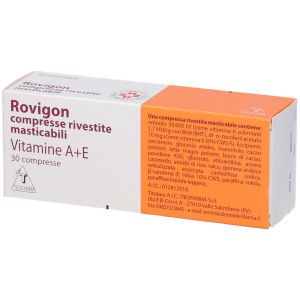Ship in Europe, Find out rates!
Rovigon 30.000 Iu 30 Chewable Coated Tablets

- box Delivery in Italy in 24/48 and free returns
- star3.000+ positive reviews
- dropboxOver 60,000 products in the catalog
NAME:
ROVIGON CHEWABLE COATED TABLETS
PHARMACOTHERAPEUTIC CATEGORY:
Vitamin preparations, associations.
ACTIVE PRINCIPLES:
Retinol; dl-alpha-tocopheryl acetate.
EXCIPIENTS:
Sucrose, anhydrous glucose, mannitol, cocoa powder, skim milk powder, cocoa butter, povidone K30, glycerol, ethylvanillin, cinnamon flavoring, rice starch, talc, dried nebulized gum arabic, sodium caramellose, beta-carotene (E 160a) 10% CWS, solid paraffin, light liquid paraffin.
INDICATIONS:
The drug is indicated in all deficient states due to malabsorption, especially lipid, or from malnutrition and related symptomatological pictures.
Furthermore, the drug, as a balanced association between vitamins A and E, is indicated in functional disorders and in the de generative manifestations of tissues of epithelial and mesodermal origin (for example degenerative retinopathies, disorders of the inner ear, etc.), especially in middle aged and elderly people.
CONTRAINDICATIONS / SECONDAR EFFECT:
Hypersensitivity to the active substance or to any of the excipients; hypervitaminosis A; children under 12 years of age; women who are pregnant or in whom a pregnancy could be established.
DOSAGE:
For oral use.
Unless otherwise prescribed, the recommended dose is 1 tablet per day for a maximum of 4 weeks.
The therapeutic cycle can be repeated throughout the year, according to medical judgment.
The dosage should be adjusted, based on the serum levels of vitamin A and vitamin E.
The medicine is contraindicated in children under 12 years of age.
STORAGE:
This medicine does not require any special storage conditions.
WARNINGS:
In order to avoid the appearance of signs and symptoms of overdosing, use the product under medical supervision and for the period of time deemed strictly necessary.
Preparations containing vitamin E d should be used with caution in diabetics and in subjects with cardiac insufficiency as this vitamin can reduce the need for insulin and digitalis.
In very prolonged therapies, especially if for several years, do not exceed the number and duration of the therapeutic cycles recommended for each year, in order not to incur the risk of chronic overdosing of vitamin A.
Due to the presence of betac arotene in the composition, prolonged use of the product can increase the risk of lung cancer in heavy smokers (ve nti or more cigarettes a day).
During pregnancy, a daily intake of vitamin A up to 10,000 IU has been shown to be safe.
However, doses above 15,000 IU / day have been associated with the possibility of malformations in humans.
Therefore, in pregnancy, daily dosages above 10,000 IU should be avoided, especially during the first trimester.
Vitamin A should not be taken together with other drugs containing vitamin A, the synthetic isomers tretinoin and etretinate or beta-carotene, as these compounds, at high doses, are considered harmful to the fetus.
In women of fertile age it is necessary to ensure that: the patient is not pregnant when the treatment starts (negative pregnancy test); the patient understands the teratogenic risk; the patient agrees to use effective contraception without interruption for the duration of the treatment and for at least one month after its cessation.
Long-term treatments with vitamin A have been associated with cirrhosis, impaired hepatic circulation, hepatic fibrosis and hepatotoxicity.
Patients with pre-existing liver disease are at increased risk of developing or worsening liver disease due to reduced production capacity of the retinal binding protein.
Patients taking high doses of vitamin A (greater than 2.50 IU / kg per day) for an extended period without interruption should be monitored for signs of hypervitaminosis A.
A maximum daily dose of 5,000 IU / kg should not be exceeded.
Before prescribing the treatment, the intake of vitamin A, isotrenitoin, etretinate and beta-carotene deriving from the diet and the possible use of supplements and concomitant drugs should be evaluated.
High doses of vitamin A have been associated with osteoporos i and osteosclerosis.
This product contains sucrose and glucose.
INTERACTIONS:
Vitamin E can enhance the action of digitalis or insulin.
Avoid concomitant use with other retinoid-containing drugs or supplements and with antibiotics belonging to the tetracycline class.
SIDE EFFECTS:
The adverse reactions listed below derive from spontaneous reports and therefore an organization by frequency categories is not possible.
Eye disorders: visual disturbances.
Gastrointestinal disorders: gastrointestinal and abdominal pain, nausea, vomiting, diarrhea.
Hepatobiliary disorders: jaundice, hepatomegaly, hepatic steatosis.
Cirros I, liver fibrosis and hepatotoxicity have been associated with long-term vitamin A therapy.
Immune system disorders: allergic reaction, allergic edema, anaphylactic reaction, anaphylactic shock.
Hypersensitivity reactions and related clinical and laboratory manifestations include mild to moderate reactions that may affect the skin, respiratory tract, gastrointestinal tract and cardiovascular system.
Diagnostic tests: abnormal liver function tests, increase in aspartate and alanine aminotransf erase, increase in blood triglycerides.
Metabolism and nutrition disorders: hypercalcemia, lipid metabolism disorder.
Pathologies of the musculoskeletal system and connective tissue: bone pain and osteoporosis; High vitamin A intake with diet or supplementation has been associated with increased osteoporosis and hip fracture risk.
Ne rvous system disorders: headache.
Sudden onset of headache may be one of the symptoms of pseudotumor cerebri.
Skin and tissue disorders: itching, hives, rash, dry skin a, exfoliative dermatitis.
The following have been associated with the chronic use of vita mina A: alopecia, dermatitis, eczema, erythema, discoloration of the skin, alterations in the structure of the hair, hypotrichosis, dryness of the mucous membranes, skin fragility, cheilitis.
Skin changes are often among the first signs of hypervitaminosis A.
The reporting of suspected adverse reactions that occur after the authorization of the medicinal product is important, as it allows continuous monitoring of the benefit / risk ratio of the drug.
PREGNANCY AND BREASTFEEDING:
During pregnancy, a daily intake of vitamin A up to 10.
000 IU proved to be safe.
However, doses above 15,000 IU / day have been associated with the possibility of malformations in humans.
Therefore, in pregnancy, daily dosages higher than 10,000 IU should be avoided, especially during the first trimester.
Vitamin A should not be taken together with other drugs containing vitamin A, the synthetic isomers tretinoin and etretinate or beta-carotene, as these compounds, in high doses, are considered harmful to the fetus.
In women of childbearing age it is necessary to make sure that: the patient is not pregnant when treatment begins (negative pregnancy test); the patient understands the teratogenic risk; the patient agrees to use effective contraception without interruption for the duration of the treatment and for at least one month after its cessation.
Adequate information is not available on the excretion of vitamin A and vitamin E in human and animal breast milk and therefore a risk for the milk cannot be excluded.
The decision whether to discontinue breast-feeding or to discontinue retinol / tocopherol therapy will be made taking into account the benefit of breast-feeding for the infant and the benefit of retinol / tocopherol therapy for the mother.


